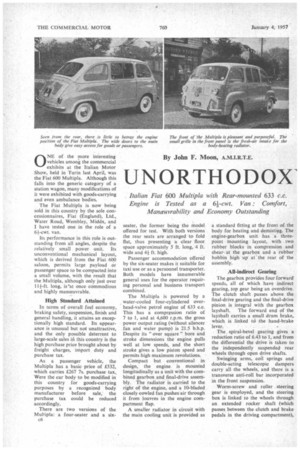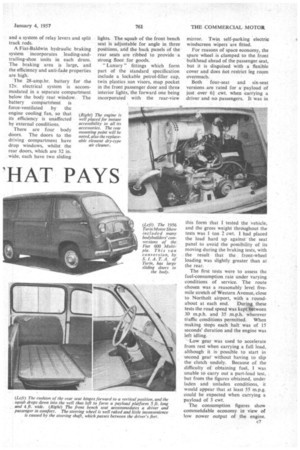UNORTHODOX'
Page 46

Page 47

Page 48

Page 49

If you've noticed an error in this article please click here to report it so we can fix it.
1HAT PAYS ONE of the more interesting vehicles among the commercial exhibits at the Italian Motor Show, held in Turin last April, was the Fiat 600 Multipla. Although this falls into the generic category of a station wagon, many modifications of it were exhibited with goods-carrying and even ambulance bodies.
The Fiat Multiple is now being sold in this country by the sole concessionnaires, Fiat (England), Ltd., Water Road, Wembley, Middx, and I have tested one in the role of a 64--cwt. van.
Its performance in this role is outstanding from all angles, despite the relatively small power unit. Its unconventional mechanical layout, which is derived from the Fiat 600 saloon, permits large payload or passenger space to be compacted into a small volume, with the result that the Multipla, although only just over 11+-ft. long, is'at once commodious and highly manceuvrable.
High Standard Attained
In terms of overall fuel economy, braking safety, suspension, finish and general handling, it attains an exceptionally high standard. Its appearance is unusual but not unattractive, and the only possible deterrent to large-scale sales in this country is the high purchase price brought about by freight charges, import duty and purchase tax.
As a passenger vehicle, the Multiple has a basic price of £532, which carries £267 7s. purchase tax. Were the car body to be modified in this country for goods-carrying purposes by a recognized body manufacturer before sale, the purchase tax could be reduced accordingly.
There are two versions of the Multiple: a four-seater and a sixc6 seater, the former being the model offered for test. With both versions the rear seats are arranged to fold flat, thus presenting a clear floor space approximately 5 ft. long, 4 ft. wide and 4+ ft. high.
Passenger accommodation offered by the six-seater makes it suitable for taxi use or as a personnel transporter. Both models have innumerable general uses for the operator requiring personal and business transport combined.
The Multipla is powered by a water-cooled four-cylindered overhead-valve petrol engine of 633 c.c. This has a ciamprcssion ratio of 7 to 1, and at 4,600 r.p.m. the gross power output rating (without silencer fan and water pump) is 21.5 b.h.p. Despite its "over square" bore and stroke dimensions the engine pulls well at low speeds, and the short stroke gives a low piston speed and permits high maximum revolutions.
Compact but conventional in design, the engine is mounted longitudinally as a unit with the combined gearbox and final-drive assembly. The radiator is carried to the right of the engine, and a 10-bladed closely cowIed fan pushes air through it from louvres in the engine compartment flap.
A smaller radiator in circuit with the main cooling unit is provided as a standard fitting at the front of the body for heating and demisting. The engine-gearbox unit has a threepoint mounting layout, with two rubber blocks in compression and shearat the gearbox and a rubber bobbin high up at the rear of the assembly.
All-indirect Gearing
The gearbox provides four forward speeds, all of which have indirect gearing, top gear being an overdrive. The clutch shaft passes above the final-drive gearing and the final-drive pinion is integral with the gearbox layshaft. The forward end of the layshaft carries a small drum brake, which is linked to the hand-brake lever. • The spiral-bevel gearing gives a reduction ratio of 6.43 to I, and from the differential the drive is taken to the independently suspended rear wheels through open drive shafts.
Swinging arms, coil springs and double-acting telescopic dampers carry all the wheels, and there is a transverse anti-roll bar incorporated in the front suspension.
Worm-screw and roller steering gear is employed, and the steering box is linked to the wheels through an extended rocker shaft (which passes between the clutch and brake pedals in the driving compartment), this form that I tested the vehicle, and the gross weight throughout the tests was 1 ton 2 cwt. I had placed the load hard up against the seat panel to avoid the possibility of its moving during the braking tests, with the result that the front-wheel loading was slightly greater than at the rear.
The first tests were to assess the fuel-consumption rate under varying conditions of service. The route chosen was a reasonably level fivemile stretch of Western Avenue, close to Northolt airport, with a round about at each end. During these tests the road speed was kept between 30 m.p.h. and 35 m.p.h. wherever traffic conditions permitted. When making stops each halt was of 15 seconds' duration and the engine was left idling.
Low gear was used to accelerate from rest when carrying a full load, although it is possible to start in second gear without having to slip the clutch unduly. Because of the difficulty of obtaining fuel, I was unable to carry out a part-load test, but from the figures obtained, under laden and unladen conditions, it would appear that at least 55 m.p.g. could be expected when carrying a payload of 3 cwt.
The consumption figures show commendable economy irr view of low rower output of the engine. This economy is partly brought about by the ability of the engine to pull hard in a high gear.
Brake tests were made under unfavourable conditions, the road being wet and greasy from recent rain. The fact that, even so, almost 100-per-cent. efficiency in terms of stopping distance was obtained when braking from 20 m.p.h. speaks volumes for the safety given by the braking system. The comparable efficiency from 30 m.p.h. was lower because of slight wheel-locking on the slippery surface, but one emergency stop made later on a dry road produced a stopping distance of 30.5 ft.
High Braking Efficiency
This high braking efficiency is not confined to the foot system, because emergency stops from 20 m.p.h., using the hand brake only, produced consistent Tapley meter readings of 33 per cent. Once again, the wheels locked because of the condition of the road surface.
Figures obtained up to 40 m.p.h. show that fast acceleration can be achieved with a small engine when the spread of gear ratios is carefully chosen. I was pleasantly surprised at the top-gear performance and when pulling away from below 10 m.p.h. in this ratio there was no sign of transmission roughness and the engine did not pink on commercialgrade petrol. The vehicle's top speed is about 56 m.p.h.
Several tests were made on hills and again the performance of the Multipla was an eye-opener. Dashwood Hill, for example, which lies north of West Wycombe, and is a mile long with an average gradient of I in 22, was climbed in top gear at a minimum road speed of 19 m.p.h. and at an average speed of 35.5 m.p.h.
Teinperature Rise Only 5° F.
During this climb, which was made in an ambient temperature of 38° F., the temperature rose by a mere 5° F. to 173° F. Only on hills with a gradient exceeding 1.in 6 did low gear become necessary, and in Harrow a successful re-start was made on a 1-in-44 gradient, the hand brake holding the vehicle in perfect safety on this slope.
In an endeavour to induce brake fade, Dashwood Hill was descended in neutral at a speed of approximately 20 m.p.h., the brakes being applied for three minutes. A" crash •' stop from 20 m.p.h. produced a Tapley meter reading of 95 per cent., indicating no fade whatever.
The Multipla is a delightful little c8 vehicle to drive. The seating position gives excellent all-round visibility and does not become tiring on long journeys. All controls are light to operate and the steering wheel is particularly well raked for comfort. The suspension provides a smooth ride over the worst of road surfaces and fast cornering was possible without any noticeable roll or deviation from the set course on wet or dry roads.
As might be expected, little is heard of the rear engine by passengers, but slight transmission noise was noticeable in all ratios, although not to the extent of becoming a nuisance. The compact dimensions of the Multipla and the good turning circle make it ideally suited for driving in congested traffic and narrow streets., Several maintenance tasks were
conducted. With the engine-compartment trap raised, the engine and its auxiliaries are well exposed for all servicing operations. A point worthy of note is that with the driving lights switched on, an inspection light in
the, engine compartment automatically lights when the trap is raised.
It was possible to check the engineoil level in 12 seconds and the water level in seven seconds, and I also noted that the oil filler cap was well placed for easy replenishment of the sump.
Being above the level of the valve cover, the distributor is particularly easy to reach, but the adjustment of timing and points is complicated by the lack of a starting handle. With the crankshaft at a right angle, however, it was possible to check the contact-breaker gap in just under 40 seconds.
Filler and Level Plug
A combined filler and level plug in the gearbox final-drive unit can be reached without too much difficulty from below the vehicle, the level being checked in 50 seconds. The air cleaner, which lies across the top of the engine, has a replaceable dry clement, which was removed in 22 seconds and replaced in 25 seconds.
Disregarding its slight intrusion into passenger space, the spare wheel is easily removed and replaced, these operations taking 22 seconds and 30 seconds, respectively.
A well-made bevel-geared pillar jack is provided in the tool kit and there are four jacking points under the body sides. Using this jack, it was possible to raise each wheel clear of the ground in 30 seconds and lower ing took 11 seconds. With each wheel raised in turn, I was able to adjust each brake unit in 15 seconds,' the whole operation therefore taking about four minutes.
Three fuses are located behind the combined lighting and ignition switch in the instrument panel. The fuses have replaceable wires (which is a money-saving arrangement) and each fuse, when once located, can be removed and replaced in five seconds.
The Multipla is an outstanding example of current Italian engineer ing practice. It is unconventional but highly efficient, and is a measure of the type of competition that the British motor industry faces in this field.








































































































